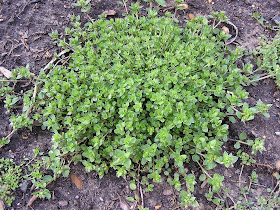Chickweed (Stellaria media) is a fast-spreading, low growing creeper of a thing and is quick to take hold of bare patches of ground. Most people think it's a weed. I personally look forward to its arrival each year.
First, it's actually kinda tasty. It's a nice, interesting addition to your spring salad. In fact, it's a traditional ingredient in a Japanese salad eaten during the Festival of Seven Herbs: Nanakusa no sekku.
Besides the culinary value, chickweed is a good herb to use for skin irritation - it's a cooling and soothing herb. I pick a big mess of it every spring and dry it in the dehydrator. After drying, I make an infused oil with it and then make a first aid salve. I usually combine equal amounts of oils infused with chickweed, calendula flower petals, and yarrow. This makes a fantastic first aid salve for cuts, bug bites, burns, chapped/chafed skin, and hemorrhoid relief. Seriously.
How can you make your own salve? Easy!
First, you need an oil infused with your herb of choice. Be sure to use herbs that have been dried. If you use fresh herbs, then the live plant matter and the water it contains can cause the oil to go bad and also cause molds and other gross stuff to grow. Trust me on this one. I once had a batch of ointment turn into a nasty goo because I used fresh plants. Yucky!
Get a clean mason jar and place the dried herb(s) inside. Cover the herb with good quality oil. Most herbalists will tell you to use olive oil, but I have also used sunflower and safflower oil with success. Really, I believe it's up to you. Use the oil you want to use. Cover the top of the jar loosely with a coffee filter secured around the jar with a rubber band. Set the jar in a sunny window and let it steep for at least a week, shaking/stirring the jar contents every day or two. You may need to add some more oil to keep the herbs covered - remember, the herbs are dried and they will soak up some of the oil.
If you're really impatient, you can take a shortcut and skip the sun-steeping. Simply place the dried herbs in a pot, cover with the oil and warm over low heat for an hour or so. LOW HEAT, ok? Don't try to deep fry your herbs! The idea is to infuse the oil with the herb's essential oils.
When you're satisfied that your oil is sufficiently infused, strain the oil into another clean mason jar and toss the herbs into the compost pile. At this point you can either save the oil by storing it in a cool, dark place and just use it straight, which is fine. Or, you can proceed to the next step and actually make a salve.
 You will need:
You will need:Infused oil(s)
Beeswax - check online, or in the candle/soap section of your arts & crafts store, or seek out your local beekeeper
Small jars or containers to put your salve in (clean baby food jars work great!)
I recommend getting a cheap pan or double boiler from a thrift store, along with cheap utensils such as a cheese grater and rubber spatula, and use them only for making salves and infused oils. Beeswax is a BOOGER to clean off! I usually wash my pans and utensils outside after having made salve, just to keep the wax from getting all over the place in my kitchen.
Slowly warm your infused oil in a pan. You only want to get it warm enough to melt beeswax. For every cup of oil, add 1 to 2 Tablespoons of grated beeswax. (The more wax you add, the firmer your salve will be.) Stir until all is melted. Remove from heat and pour into containers.
If the end result is firmer than you wanted, just reheat everything and add a little olive oil (or oil of your choice). If it isn't firm enough, reheat and add a little more beeswax. It's very much a trial-and-error process and definitely not an exact science.
The chickweed / calendula / yarrow salve is a good, basic ointment, easy to make, and good to have on hand for general first-aid... and you didn't have to pay Big Pharma a nickel for it!

No comments:
Post a Comment
Thank you so much for visiting. I appreciate your leaving a comment. Come back and visit anytime!